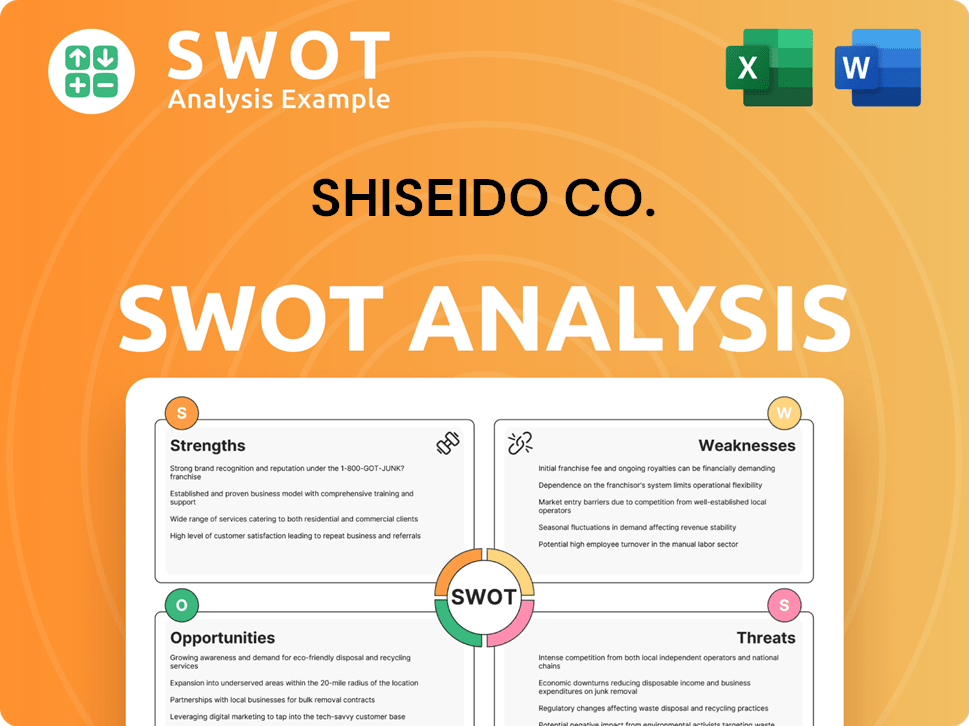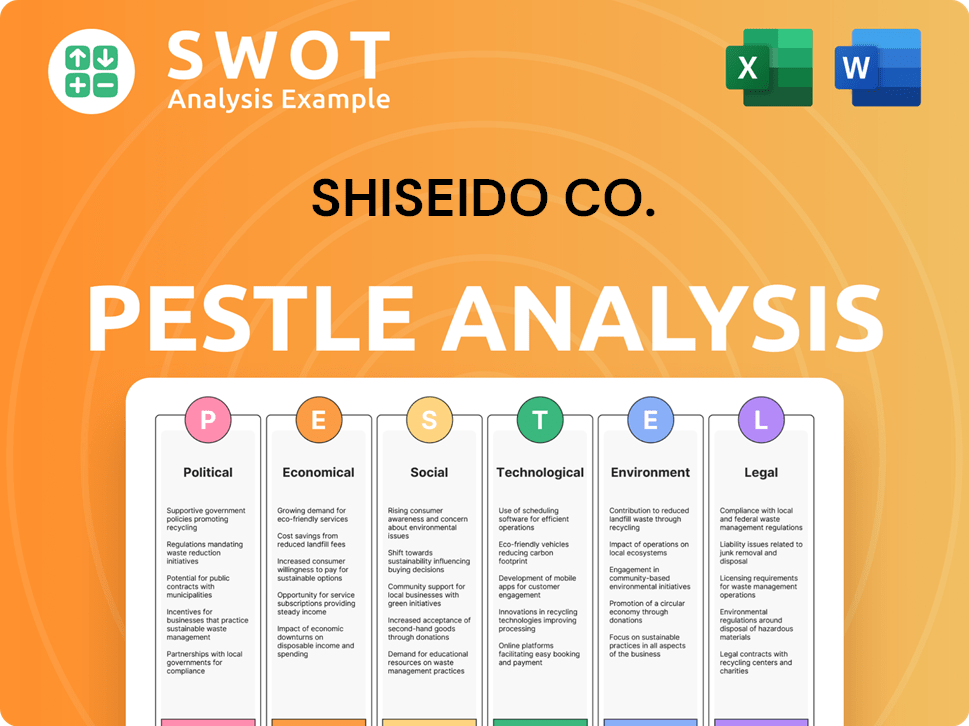Shiseido Co. Bundle
Who Really Controls Shiseido?
Uncover the intricate web of power behind one of the world's leading beauty giants. Understanding Shiseido Co. SWOT Analysis is crucial to making informed investment decisions. With a recent CEO succession, the question of Shiseido ownership and its future direction is more pertinent than ever. This deep dive explores the company's ownership structure, revealing the key players shaping its destiny.

Knowing who owns Shiseido, from its founding to its current status as a publicly traded corporation, offers valuable insights. This analysis will dissect the Shiseido company structure, examining its major shareholders and the influence they wield. Explore the historical shifts in Shiseido's ownership and how these changes have impacted its strategic trajectory and financial performance in the competitive beauty market.
Who Founded Shiseido Co.?
The story of Shiseido Co. began on September 17, 1872, when Arinobu Fukuhara established the Shiseido Pharmacy in Tokyo's Ginza district. This marked the genesis of what would become a global leader in the beauty industry. Fukuhara, a former chief pharmacist for the Imperial Japanese Navy, aimed to improve the quality of medicine and dispensary practices.
The name 'Shiseido' itself carries significant meaning, derived from a passage in the Chinese classic I Ching. It translates to 'praise the virtues of the earth which nurtures new life and brings forth significant values,' reflecting the founder's vision. While the initial ownership structure isn't explicitly detailed, Arinobu Fukuhara's influence was paramount in the company's early years.
The company's evolution from a pharmacy to a cosmetics giant is a testament to its adaptability and vision. The introduction of Eudermine in 1897 and the establishment of the Cosmetics Division in 1916 were key milestones. The formal incorporation as a Japanese joint-stock company (kabushiki gaisha) in 1927 marked a significant step in its corporate structure.
The early ownership of Shiseido was centered around the Fukuhara family. Arinobu Fukuhara's vision drove the initial establishment, and his son, Shinzo Fukuhara, played a crucial role in shaping the company's future. Shinzo became the first president after the company's incorporation in 1927, solidifying the family's influence. Shiseido's transformation included expanding into cosmetics and developing its global presence.
- 1872: Arinobu Fukuhara founds Shiseido Pharmacy.
- 1897: Introduction of Eudermine, marking the entry into cosmetics.
- 1916: Establishment of the Cosmetics Division.
- 1927: Formal incorporation as a joint-stock company, with Shinzo Fukuhara as president.
Shiseido Co. SWOT Analysis
- Complete SWOT Breakdown
- Fully Customizable
- Editable in Excel & Word
- Professional Formatting
- Investor-Ready Format

How Has Shiseido Co.’s Ownership Changed Over Time?
The ownership structure of Shiseido Co., a publicly traded company, has evolved over time, reflecting shifts in investor sentiment and strategic decisions. As a publicly traded entity on the Tokyo Stock Exchange (TYO: 4911) and with American Depositary Receipts (ADRs) traded over-the-counter (OTCPK: SSDOY) in the U.S., the company's ownership is primarily dispersed among institutional and individual investors. Understanding the dynamics of Shiseido's business model and its ownership is crucial for assessing its market position and future prospects.
Key events impacting Shiseido's ownership include the ongoing adjustments in the holdings of major institutional investors. The fluctuations in shareholdings by firms like BlackRock, Norges Bank Investment Management, and others, demonstrate the active management of portfolios and the continuous evaluation of Shiseido's performance and strategic direction. These shifts can influence the company's stock price and strategic decisions.
| Shareholder | Shareholding Percentage (as of late 2024/early 2025) | Shares Held |
|---|---|---|
| The Master Trust Bank of Japan, Ltd. (Trust Account) | 19.07% | 76,196 thousand |
| Independent Franchise Partners LLP | 7.29% (May 12, 2025) | 29,115,216 |
| BlackRock, Inc. | 7.34% (December 30, 2024) | 29,330,457 |
| Norges Bank Investment Management | 6.41% (February 4, 2025) | 25,584,993 |
| Nomura Asset Management Co., Ltd. | 6.21% (May 14, 2025) | 24,815,523 |
| The Vanguard Group, Inc. | 3.82% (March 30, 2025) | 15,265,270 |
| Custody Bank of Japan, Ltd. (Trust Account) | 6.77% | 27,073 thousand |
| Baillie Gifford & Co. | 4.07% (December 12, 2024) | 16,260,963 |
As of December 31, 2024, Shiseido had 400,000,000 common shares issued, with 576,863 in treasury stock, and a total of 131,423 shareholders. Institutional investors hold a significant portion of the shares, influencing the company's strategic direction. The largest shareholders include The Master Trust Bank of Japan, Ltd., Independent Franchise Partners LLP, BlackRock, Inc., and Norges Bank Investment Management. These major shareholders and their strategies play a crucial role in shaping the company's future.
Shiseido's ownership structure is primarily influenced by institutional investors.
- Institutional investors hold a significant portion of Shiseido's shares.
- Major shareholders include The Master Trust Bank of Japan, Ltd., BlackRock, and others.
- Ownership changes reflect dynamic investment strategies.
- Understanding the ownership is key to assessing the company's market position.
Shiseido Co. PESTLE Analysis
- Covers All 6 PESTLE Categories
- No Research Needed – Save Hours of Work
- Built by Experts, Trusted by Consultants
- Instant Download, Ready to Use
- 100% Editable, Fully Customizable

Who Sits on Shiseido Co.’s Board?
As of March 26, 2024, the company implemented a Company with Three Statutory Committees structure to enhance its corporate governance. The Board of Directors, as of fiscal year 2024, comprises eleven (11) Directors, including seven (7) External Directors. This structure aims to determine basic management policy and strategy while overseeing their implementation. The shift towards a committee-based system, along with a focus on independent external directors, suggests a commitment to transparency in governance practices. Understanding the Growth Strategy of Shiseido Co. provides further context on the company's operational direction.
Effective January 1, 2025, Kentaro Fujiwara will assume the roles of Director, Representative Corporate Executive Officer, President, and CEO. Yoshihiko Hatanaka, an external director, will become Chairman of the Board of Directors on the same date. New appointments to the Board include Ayako Hirofuji as Representative Corporate Executive Officer and Director, and Yasuhiro Nakajima as External Director. Nakajima's expertise in accounting is expected to benefit the Board. The Nominating Committee, composed of four External Directors, will oversee the appointment and dismissal of key executive officers, highlighting the emphasis on independent oversight.
| Director | Role | Effective Date |
|---|---|---|
| Kentaro Fujiwara | Director, Representative Corporate Executive Officer, President, CEO | January 1, 2025 |
| Yoshihiko Hatanaka | Chairman of the Board of Directors | January 1, 2025 |
| Ayako Hirofuji | Representative Corporate Executive Officer and Director | January 1, 2025 |
| Yasuhiro Nakajima | External Director | January 1, 2025 |
The company is enhancing its corporate governance through a committee-based system and a focus on independent external directors. This structure aims to improve transparency and fairness. The Nominating Committee plays a crucial role in overseeing executive appointments.
- Board composition includes a majority of External Directors.
- Key executive appointments are overseen by the Nominating Committee.
- The separation of execution and oversight is strengthened.
- Emphasis on maximizing corporate and shareholder value.
Shiseido Co. Business Model Canvas
- Complete 9-Block Business Model Canvas
- Effortlessly Communicate Your Business Strategy
- Investor-Ready BMC Format
- 100% Editable and Customizable
- Clear and Structured Layout

What Recent Changes Have Shaped Shiseido Co.’s Ownership Landscape?
In the past few years, the Shiseido has experienced significant shifts in its leadership and ownership strategies. A planned CEO succession culminated in Kentaro Fujiwara taking the helm as Director, Representative Corporate Executive Officer, President, and CEO on January 1, 2025. This transition followed a share buyback in August 2024, where the company repurchased 300,000 common shares, representing 0.08% of issued capital, for approximately ¥1.04 billion. These actions are indicative of adjustments within the Shiseido company structure.
The company's strategic vision includes becoming a 'Personal Beauty and Health Company.' In December 2023, Shiseido launched its first corporate venture capital fund, LIFT Ventures, with a Western focus, to invest in early-stage beauty and wellness companies. This move reflects an industry trend towards strategic investments to boost future revenue. Despite these initiatives, the company faced challenges in 2024, with operating profits dropping by 73.1% to ¥7.58 billion, mainly due to a slowdown in consumer spending in China. For a deeper dive into the Shiseido, consider exploring the Marketing Strategy of Shiseido Co.
| Metric | Value | Year |
|---|---|---|
| Net Sales | ¥990.6 billion | 2024 |
| Operating Profit | ¥7.58 billion | 2024 |
| Net Loss Attributable to Owners | ¥10.8 billion | 2024 |
| Market Capitalization | S$8.88 billion | May 2025 |
The company's market capitalization as of May 2025 was approximately S$8.88 billion, reflecting a decrease of 7.65% from 2024. Shiseido forecasts a moderate recovery in profits for fiscal year 2025, driven by strategic initiatives despite expected continued challenges in China and travel retail. This indicates ongoing efforts to manage Shiseido's ownership and financial performance.
Kentaro Fujiwara became CEO on January 1, 2025. Executive changes were announced for July 1, 2025, and April 15, 2025.
In August 2024, 300,000 shares were repurchased. The buyback represented 0.08% of issued share capital.
LIFT Ventures launched in December 2023. The fund focuses on early-stage beauty and wellness companies.
Operating profits decreased by 73.1% in 2024. Net sales increased by 1.8% in 2024.
Shiseido Co. Porter's Five Forces Analysis
- Covers All 5 Competitive Forces in Detail
- Structured for Consultants, Students, and Founders
- 100% Editable in Microsoft Word & Excel
- Instant Digital Download – Use Immediately
- Compatible with Mac & PC – Fully Unlocked

Related Blogs
- What are Mission Vision & Core Values of Shiseido Co. Company?
- What is Competitive Landscape of Shiseido Co. Company?
- What is Growth Strategy and Future Prospects of Shiseido Co. Company?
- How Does Shiseido Co. Company Work?
- What is Sales and Marketing Strategy of Shiseido Co. Company?
- What is Brief History of Shiseido Co. Company?
- What is Customer Demographics and Target Market of Shiseido Co. Company?
Disclaimer
All information, articles, and product details provided on this website are for general informational and educational purposes only. We do not claim any ownership over, nor do we intend to infringe upon, any trademarks, copyrights, logos, brand names, or other intellectual property mentioned or depicted on this site. Such intellectual property remains the property of its respective owners, and any references here are made solely for identification or informational purposes, without implying any affiliation, endorsement, or partnership.
We make no representations or warranties, express or implied, regarding the accuracy, completeness, or suitability of any content or products presented. Nothing on this website should be construed as legal, tax, investment, financial, medical, or other professional advice. In addition, no part of this site—including articles or product references—constitutes a solicitation, recommendation, endorsement, advertisement, or offer to buy or sell any securities, franchises, or other financial instruments, particularly in jurisdictions where such activity would be unlawful.
All content is of a general nature and may not address the specific circumstances of any individual or entity. It is not a substitute for professional advice or services. Any actions you take based on the information provided here are strictly at your own risk. You accept full responsibility for any decisions or outcomes arising from your use of this website and agree to release us from any liability in connection with your use of, or reliance upon, the content or products found herein.